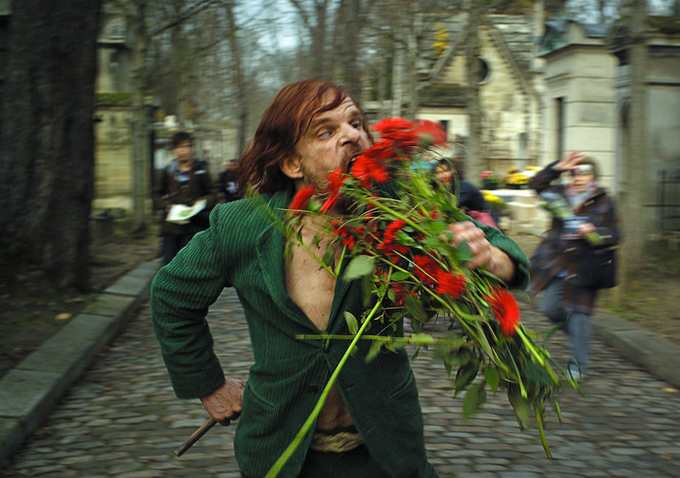Holy Motors is perhaps the biggest
wild card the movies will have to play in 2012, which – at a time of corporate
safe bets – is almost a recommendation in itself. Yet it may be better to let cinéma du look alumnus Leos
Carax’s return to our screens ambush you, as it did the critics in Cannes this
summer, than have anybody attempt to analyse or synopsise it beforehand –
because this is patently a film beyond analysis and synopses, in ways both good
and bad. If you ran across it at a party, you’d walk away regarding it as a bit
of a character. More precisely, it’s bits of several characters, and that’s
really about it.
After
waving au revoir to his family one
morning, Denis Lavant’s Monsieur Oscar repairs to a limousine, where his
chauffeur (Edith Scob) informs him he has nine “appointments” for the day. The
limo proves to be a roving prop box, in which Lavant/Oscar will make himself up
to play nine roles: among them, a Russian peasant woman, a motion capture
artist, a green-suited goblin (the Monsieur Merde character road-tested in
Carax’s third of the portmanteau film Tokyo!),
and both a bullet-headed gangster and his doppelganger victim, which presumably
counts as a double shift. Quite why he’s shifting shapes goes unexplained: as
night falls, the limos we’ve seen circling the city’s streets are returned to
the garage of the title and left, like the audience, to talk among themselves.
That
essential emptiness – where narrative development or thematic substance would
conventionally go – has left some early reviewers to fill Holy Motors with grand claims. Is it really a mobile history of the
cinema, stopping off at Muybridge, Cocteau and Godard en route? Maybe. It’s
unquestionably a strong vehicle for its leading man, shuttling between
identities like a subtitled Mr. Benn. (Another cartoonish touch: characters
die, only to pick themselves off the floor and get on to the next gig.) Taking
a childish delight in dressing up and messing around, this is no Serious Art
Film; any profundity here has been assigned to it, rather than driven at.
The
Merde episode best displays the film’s strengths and limitations: it has funny
ideas to run with, like the graveyard full of tombstones promoting websites,
but gets into trouble when it starts equating men who prefer their women in
burqas to dirty, gibbering cavedwellers. After this sudden burst of rude energy
– in which Eva Mendes is as much of a stooge as the passers-by in Dom Joly
skits – Holy Motors begins to run out
of gas: the accordion interlude is stirring, but otherwise we’re stuck with
rather more prosaic transformations (a stressed father, a dying old man), and
Kylie in Jean Seberg clothing singing an unusually forgettable Neil Hannon
song.
Less
visually striking than Carax’s cinéma du
look output, its tactics remain broadly the same: to divert and seduce the
eye with novelties, without having much to say once the eye has alighted upon
them. It’s enjoyably eccentric, often amusing, even reassuring, in providing
ample proof the cinema can still, even now, throw up this kind of curveball.
Yet Carax is only ever working on the same level as the fashion photographer
the Merde segment seeks to satirise, gushing “Beauty! Beauty! Beauty!”, then
“Weird! So weird! Weird!” Holy Motors
has a little of both, granted, but possibly not as much as those who first saw
it saw in it.
Holy Motors opens in selected cinemas from today.

No comments:
Post a Comment